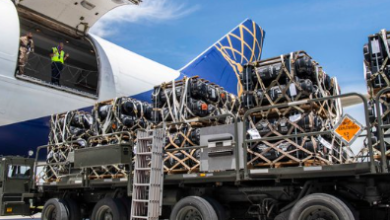Defense Official Says European Ammo Production Is Leaving America In The Dust. That’s Nonsense, Experts Say

A European defense leader boasted that the European defense industry is far outstripping American domestic production for an important munition, but experts told the Daily Caller News Foundation he was way off the mark.
Jan Jires, a top policy official in the Czech defense ministry, touted that Germany’s Rheinmetall is already producing more 155mm artillery shells than U.S. defense companies at a U.S. think tank event on Feb. 28 focused on Ukraine’s munitions requirements. However, Jires’ statement is misleading, not only because it overstates European production capacity relative to the U.S. but misrepresents European countries’ willingness to invest in their own defense and rearming Ukraine, experts told the Daily Caller News Foundation.
“Some crucial segments of the European defense industry are now performing better than U.S. defense industry,” Jires, the Czech deputy minister for defense policy and strategy, said at an event at the Hudson Institute featuring Western leaders and experts. “Rheinmetall in Germany is producing way more 155 artillery shells than the entire U.S. defense industry combined.”
Rheinmetall is a massive arms manufacturer headquartered in Germany and a leading supplier of weapons, including 155mm artillery shells, for Germany and customers around the world.
“Jires’ comments were a bit misleading as the realities within both Europe’s current production capacity for long range artillery, and its willingness to actually fund production within those facilities are markedly different than what he conveyed,” John Venable, senior researcher for defense policy at the Heritage Foundation, told the DCNF.
“There is little doubt whatever capacity Europe holds for long range artillery munitions, it is both inadequate and likely lagging that of the United States,” he said.
The war in Ukraine has exposed deficiencies in American and European weapons arsenals, including in its stockpiles of the 155mm long-range artillery projectiles. The U.S. has supplied Ukraine with roughly 2 million 155mm artillery shells since the beginning of the war in February 2022, according to a fact sheet dated Dec. 17, the last time the Biden administration announced a security assistance package for Ukraine.
Officials have blamed ammunition shortages for Ukraine’s recent loss of Avdiivka to the Russians; some estimates said Russia held a 10-to-1 shell advantage. Previous estimates have Ukraine firing between 6,000 to 7,000 155mm rounds daily during the most intense artillery battles.
In response, the U.S. and Europe have doubled down on pledges to invest in defense industrial capacity and boost production, both to ensure a flow of ammunition to Ukraine and ensure they can keep their own stockpiles at acceptable levels.
Rheinmetall plans to produce 700,000 rounds annually by 2025 at its facilities in Germany, Spain, South Africa, Australia and Hungary, according to a Feb. 11 press release. That amounts to 58,000 rounds monthly, and much of that production depends on plants that are still under construction.
It couldn’t be determined what Rheinmetall’s present monthly production rate is. When reached for comment, a spokesperson for the company told the DCNF they do not reveal exact production figures “for reasons of competition.”
“Rheinmetall is doing everything it can to make its contribution here as the most important ammunition producer in Europe,” Oliver Hoffmann, the spokesperson, said.
Annual production was 350,000 rounds in 2023; set to double to 700,000 a year by 2025 through existing sites and another located in lower Saxony where the groundbreaking took place in February, Hoffmann said. Future investments in Ukraine and Lithuania will supplement that capacity, until Rheinmetall alone can supply nearly 1 million rounds yearly.
Still, that’s not far off from the U.S. Army’s current production or future estimates.
“It’s [an] impressive target for Germany but not ‘way more than the entire U.S. defense industry combined,’” retired Col. Mark Cancian, a senior adviser at the Center for Strategic and International Studies (CSIS), told the DCNF, also expressing skepticism with Jires’ statement.
At the moment, the Army is producing 28,000 rounds per month, Army spokesperson Ellen Lovett told the DCNF. By the end of the calendar year, or early into 2025 at the latest, the Army should be producing 70 to 80,000 shells monthly, Lovett added.
In April 2022, the Army planned to reach 80,000 rounds monthly by late 2028. But the service has progressed much faster than expected, and is now on track to reach that number by mid-2025, according to slides the Pentagon’s weapons chief presented at a CSIS event in February. By April 2024 it should reach 37,000 rounds monthly, and 60,000 by October, the slides showed.
At least some of the shells from new production were shipped straight to Ukraine, Army acquisition secretary Doug Bush said in November, Defense One reported. The surprising increases are due in part to five new facilities the Army is building in Texas and about $3 billion in funding increases, according to the outlet.
“If larger stockpiles are a way to mitigate risk for an extended conventional conflict, then that needs to be looked at,” Bush said.
The Army buys from both government and contractor-owned facilities. For example, metal parts production is completed in plants in Pennsylvania, including Scranton Army Ammunition Plant and the Wilkes Barre facility. Another facility in Mesquite, Texas, is expected to come online in 2024 for the same purpose, Lovett told the DCNF.
Other artillery production facilities not owned by Rheinmetall contribute to the EU’s production capacity. Taken together, it’s possible Europe’s total capacity may surpass the U.S. production estimates by late 2025, Venable said.
“While capacity is important, whether or not Europe will actually fund production within those facilities remains a big question,” Venable said.
In March of 2023, the European Union said it was on track to deliver 1 million 155mm rounds to Ukraine within 12 months by drawing from existing stockpiles and producing more. Thierry Breton, EU executive’s acting defense commissioner, claimed that the EU’s total manufacturing capacity could already sustain that rate and reach 2 million rounds by 2025, although Venable said he’s seen little evidence to support those claims.
But as of January, the EU had only delivered 330,000 shells to Ukraine, and most of those it raided from existing stocks, the EU’s top foreign affairs minister said. He estimated the EU would achieve just over half of its 1 million round goal by March.
It’s unclear still how many of those rounds will actually end up in the launch tubes of Ukrainian-operated Howitzers and other weapons, Venable explained.
Europe’s actual annual production of artillery shells is a closely guarded secret. A recent report from the Estonian Ministry of Defense estimated Europe produces between 40,000 and 58,000 rounds per month.
“Either the EU was never serious about its promise of a million rounds over the last year, or their production capacity was unable to fulfill that promise,” Venable said. “Europe’s collective investment in defense is growing, but it is still insufficient to defend against, much less deter the threat that is rapidly growing to its East,” he added.
To prepare for future conflict, the U.S. is depending on European partners to help supply Ukraine with the ammunition required to fend off Russia’s onslaught, Lt. Gen. Leonard J. Kosinski, the U.S. Joint Staff’s logistics director, said at the Hudson event. The U.S. has failed to prepare for a near-peer fight, such as with Russia or China, through mass produciton of munitions, he argued.
The Department of Defense (DOD) later featured Jires’ statement in a story making the case for boosting ammunition production, including 155mm shells.
Meanwhile, the Army’s ability to meet its targets is under threat as Congress is months behind passing an annual funding bill for the DOD. The Army has fought to include funding for 155mm production increases in the supplemental funding bills Congress has approved for Ukraine aid, according to Defense One.
The Czech Ministry of Defense did not respond to multiple requests for comment.
Content created by The Daily Caller News Foundation is available without charge to any eligible news publisher that can provide a large audience. For licensing opportunities of our original content, please contact licensing@dailycallernewsfoundation.org




